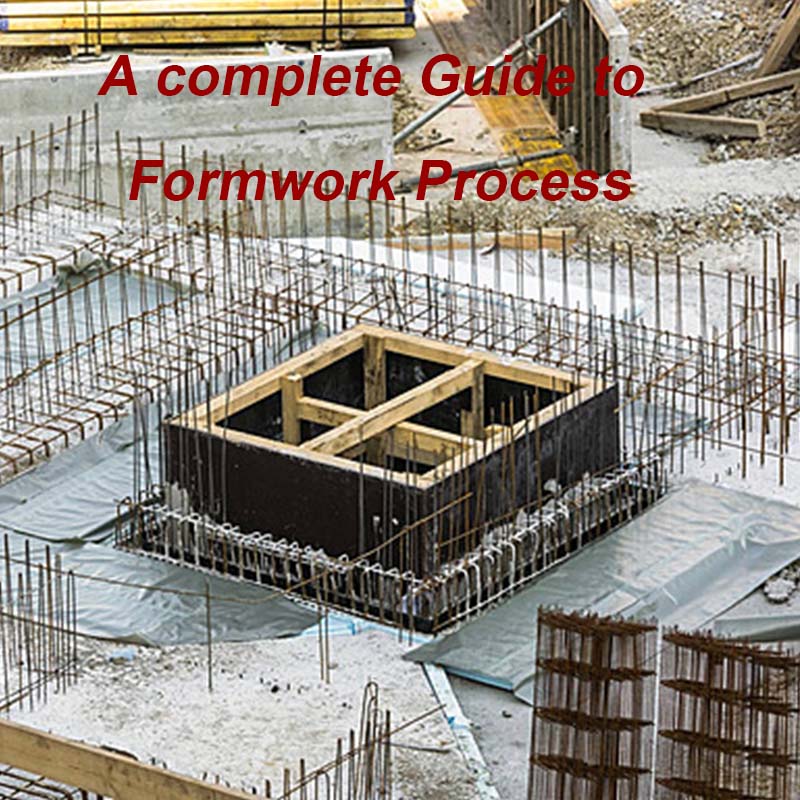A complete Guide to Formwork Process
Mar 26, 2025
The formwork process is a very important step when building with concrete. The curing process and shape retention of concrete are inseparable from the formwork process. Whether a construction project is a small residential project or a large commercial project, it is important to consider the forming process for cost, efficiency, and structural integrity. This guide will explain the forming process and its key steps, types of forming, best practices, and potential problems.
What is Formwork Process
The formwork process is the creation of temporary moulds or structures to contain the wet concrete until it attains sufficient strength to support itself. The formwork is an integral part of giving the concrete its intended shape, whether beams, columns, slabs, or walls.
Types of Cconstruction Formwork
Traditional Timber Formwork
- Conventional timber formwork usually consists of wood or plywood for smaller applications.
- Timber formwork is cost-effective, but timber formwork typically requires significant labor and experience.
- Timber formwork is most suitable for forms that are used only once or for a limited number of applications.
Steel Formwork.
- Steel formwork consists of more costly steel panels, but a stronger formwork option.
- Steel formwork is most suitable for larger applications, and multiple reuse.
- Steel provides a nice finish for concrete.
Plastic Formwork
- Plastic formwork is a lightweight, simple-to-assemble reuse option.
- Plastic formwork is resistant to chemicals and waterproof, making it ideal for wet applications.
- Plastic formwork is best suited for repetitive concrete applications, or modular applications.
Aluminum Shuttering formwork
- Aluminum shuttering is light in weight, environmentally friendly, and easy to transport and install.
- Aluminum formwork is more pricey than timber, but aluminum formwork can be financially advantageous if used several times.
- Aluminum formwork is popular in high-rise construction because of the speed of installation.
Plywood Formwork
- Plywood formwork consists of thin sheets of wood that are glued together.
- Plywood formwork provides a smooth finish, and a consistent cost-effective option.
- Plywood can be reused, but the number of reused application-wise is dependent on the appropriate use of plywood formwork without any damage during use or extending the limits of plywood use.
A Step-by-step Guide to the Formwork Construction Process
Step 1: Forethought and Design
Delineate the requirements for planning the formwork. Prepare the structural design drawings and details. Consider the safety load-bearing capability and the related cost, as well as public safety and other building SAFETY Codes.
Step 2: Site Preparation
Prepare the site to establish a suitable grade level and construction install until work begins. Mark locations for all formwork as shown in the construction documents. Prepare any reinforcement (steel bars or mesh) as needed.
Step 3: Formwork Assembly and Install
Begin the assembly of filler paneling, form framework, or modular form, as required by your designs. Check for proper plumb, seal joints, and brace the formwork as needed. Apply commercially available materials to the outside of the formwork to assist in the release of the cement pour.
Step 4: Pour Cement
During the pour operation, be sure that you limit voids and trap air in the form wall. You can use vibrators to remove air and properly fill voids. Keep an eye out for any leaks, and check the formwork for any movement outside of the designed structural elements.
Step 5: Initial Curing and Set
After sufficient time has passed, the initial set time of concrete generally is 24-48 hours. Allow the cement to hydrate, and maintain proper moisture as outlined above.
Step 6: Form Removal (Stripping)
After the concrete has gained enough strength, remove the formwork. Look at the concrete compressive strength when determining proper stripping time. Once the formwork has been removed, inspect the surface for any intrusion or lighting.
Step 7: Form Cleaning and Storag
The formwork needs to be cleaned as necessary for reuse. The formwork needs to be stored in a dry and protected area for preservation . Inspect for any damaged materials that may need to be replaced.
Best Practices for Efficient Formwork Process
Formwork is an essential component of concrete construction and can significantly affect a project's efficiency, quality, and overall cost of a project. Best practices for form working practices help facilitate the seamless execution of project requirements and reduce unnecessary downtime while improving site safety. Here are some of the best practices to use with an efficient formworking process.
Use modern formwork planning technologies (e.g., Building Information Modelling [BIM] or 3-D modeling software) when planning and/or optimizing the formwork design, after which proper load calculations must be performed to ensure the proper strength and stability of the final structure.
When selecting between traditional wood, steel, aluminum, or modular formwork systems, be sure to consider the project size, complexity, budget, and reusability of the formwork system.
Examine materials before installation to detect signs of wear. Choose durable, reusable materials that do not exhibit warping, cracks, or defects.
Improving the overall integrity of structure through the use of adjustable braces, cross braces, or tie rods, is one practice that can significantly improve structure strength. Using positive restraint on formworking elements will limit the movement of the formwork and therefore the movement of the concrete.
Use rubber washers or foam strips to seal joints and avoid losing grout from them. Tight-fitting material ensures that form working fits together and reduces honeycombing and surface defects.
Manage and cure concrete in smaller workability units to avoid overloading the formwork. Utilize vibrating concrete tools to eliminate air and ensure the concrete stays compacted.
Avoid stripping the forms too early to prevent cracking or weakened structural integrity. Observe suggested cure durations based on the governing temperature, moisture levels, and concrete mix ratios.
Safely and methodically remove the formwork: remove the non-load-bearing units to discharge the load-bearing supports first. Utilize form release agents to assist with removal so that there is no or minimal disturbance to the concrete surface.
Ensure that the concrete has gained sufficient compressive strength before removing the forms and conducting field strength testing, if applicable.
Store and clean the formwork appropriately.
Comply with all safety requirements: ensure that appropriate safety training is provided on formwork installation and removal. Comply with all federal OSHA (Occupational Safety and Health Administration), state, and local building codes and regulations.
Follow up with ongoing safety checks: describe the safety checks that should be initiated before the initial pour, such as verifying and assuring forms supports and connections are solid and stable before the pour commences.
Conclusion
The formwork process is one of the key roles in concrete construction to ensure structural integrity, efficiency, and cost control. The right types of forms and best management procedures, safety practices, and guidelines will yield viable concrete structures that offer desirable concrete construction today.
Would you like to learn more about formwork solutions or materials? Contact us today about custom forms that meet your project's specifications!
FAQ
What are the different types of formwork?
Common types include:
-Timber formwork (traditional, low-cost but labor-intensive)
- Plywood formwork (lightweight, easy to handle)
- Steel/Aluminum formwork (durable, reusable, used in modular systems)
- Plastic formwork (lightweight, for repetitive designs)
- Engineered systems (PERI, Mivan, Doka – fast, precise)
- Slipform & Jumpform (for tall structures like towers, chimneys)
How long should formwork stay in place before removal?
It depends on the concrete strength and weather conditions:
- Walls & columns → 1–2 days
- Slabs → 7–14 days (props may stay longer)
- Beams & heavy loads → 14–28 days
Engineers check concrete strength (usually 50–70% of design strength) before stripping.
Read More
Formwork —— Wikipedia
Top 10 Best Practices for Efficient Formwork Installation on Construction Sites —— WowMaterials

